基于 abp vNext 和 .NET Core 开发博客项目 - 博客接口实战篇(一)
1|0系列文章
- 基于 abp vNext 和 .NET Core 开发博客项目 - 使用 abp cli 搭建项目
- 基于 abp vNext 和 .NET Core 开发博客项目 - 给项目瘦身,让它跑起来
- 基于 abp vNext 和 .NET Core 开发博客项目 - 完善与美化,Swagger登场
- 基于 abp vNext 和 .NET Core 开发博客项目 - 数据访问和代码优先
- 基于 abp vNext 和 .NET Core 开发博客项目 - 自定义仓储之增删改查
- 基于 abp vNext 和 .NET Core 开发博客项目 - 统一规范API,包装返回模型
- 基于 abp vNext 和 .NET Core 开发博客项目 - 再说Swagger,分组、描述、小绿锁
- 基于 abp vNext 和 .NET Core 开发博客项目 - 接入GitHub,用JWT保护你的API
- 基于 abp vNext 和 .NET Core 开发博客项目 - 异常处理和日志记录
- 基于 abp vNext 和 .NET Core 开发博客项目 - 使用Redis缓存数据
- 基于 abp vNext 和 .NET Core 开发博客项目 - 集成Hangfire实现定时任务处理
- 基于 abp vNext 和 .NET Core 开发博客项目 - 用AutoMapper搞定对象映射
- 基于 abp vNext 和 .NET Core 开发博客项目 - 定时任务最佳实战(一)
- 基于 abp vNext 和 .NET Core 开发博客项目 - 定时任务最佳实战(二)
- 基于 abp vNext 和 .NET Core 开发博客项目 - 定时任务最佳实战(三)
- 基于 abp vNext 和 .NET Core 开发博客项目 - 博客接口实战篇(一)
- 基于 abp vNext 和 .NET Core 开发博客项目 - 博客接口实战篇(二)
- 基于 abp vNext 和 .NET Core 开发博客项目 - 博客接口实战篇(三)
- 基于 abp vNext 和 .NET Core 开发博客项目 - 博客接口实战篇(四)
- 基于 abp vNext 和 .NET Core 开发博客项目 - 博客接口实战篇(五)
- 基于 abp vNext 和 .NET Core 开发博客项目 - Blazor 实战系列(一)
- 基于 abp vNext 和 .NET Core 开发博客项目 - Blazor 实战系列(二)
- 基于 abp vNext 和 .NET Core 开发博客项目 - Blazor 实战系列(三)
- 基于 abp vNext 和 .NET Core 开发博客项目 - Blazor 实战系列(四)
- 基于 abp vNext 和 .NET Core 开发博客项目 - Blazor 实战系列(五)
- 基于 abp vNext 和 .NET Core 开发博客项目 - Blazor 实战系列(六)
- 基于 abp vNext 和 .NET Core 开发博客项目 - Blazor 实战系列(七)
- 基于 abp vNext 和 .NET Core 开发博客项目 - Blazor 实战系列(八)
- 基于 abp vNext 和 .NET Core 开发博客项目 - Blazor 实战系列(九)
- 基于 abp vNext 和 .NET Core 开发博客项目 - 终结篇之发布项目
从本篇就开始博客页面的接口开发了,其实这些接口我是不想用文字来描述的,太枯燥太无趣了。全是CRUD,谁还不会啊,用得着我来讲吗?想想为了不半途而废,为了之前立的Flag,还是咬牙坚持吧。
2|0准备工作
现在博客数据库中的数据是比较混乱的,为了看起来像那么回事,显得正式一点,我先手动搞点数据进去。
搞定了种子数据,就可以去愉快的写接口了,我这里将根据我现在的博客页面去分析所需要接口,感兴趣的去点点。
为了让接口看起来清晰,一目了然,删掉之前在IBlogService中添加的所有接口,将5个自定义仓储全部添加至BlogService中,然后用partial修饰。
在Blog文件夹下依次添加接口:IBlogService.Post.cs、IBlogService.Category.cs、IBlogService.Tag.cs、IBlogService.FriendLink.cs、IBlogService.Admin.cs。
在Blog/Impl文件夹下添加实现类:IBlogService.Post.cs、BlogService.Category.cs、BlogService.Tag.cs、BlogService.FriendLink.cs、BlogService.Admin.cs。
同上,.Application.Caching层也按照这个样子添加。
注意都需要添加partial修饰为局部的接口和实现类,所有文章相关的接口放在IBlogService.Post.cs中,分类放在IBlogService.Category.cs,标签放在IBlogService.Tag.cs,友链放在IBlogService.FriendLink.cs,后台增删改所有接口放在IBlogService.Admin.cs,最终效果图如下:
3|0文章列表页
分析:列表带分页,以文章发表的年份分组,所需字段:标题、链接、时间、年份。
在.Application.Contracts层Blog文件夹下添加返回的模型:QueryPostDto.cs。
模型为一个年份和一个文章列表,文章列表模型:PostBriefDto.cs。
搞定,因为返回时间为英文格式,所以CreationTime 给了字符串类型。
在IBlogService.Post.cs中添加接口分页查询文章列表QueryPostsAsync,肯定需要接受俩参数分页页码和分页数量。还是去添加一个公共模型PagingInput吧,在.Application.Contracts下面。
Page设置默认值为1,Limit设置默认值为10,Range Attribute设置参数可输入大小限制,于是这个分页查询文章列表的接口就是这个样子的。
ServiceResult和PagedList是之前添加的统一返回模型,紧接着就去添加一个分页查询文章列表缓存接口,和上面是对应的。
分别实现这两个接口。
PageByIndex(...)、TryToDateTime()是.ToolKits层添加的扩展方法,先查询总数,然后根据时间倒序,分页,筛选出所需字段,根据年份分组,输出,结束。
在BlogController中添加API。
[FromQuery]设置input为从URL进行查询参数,编译运行看效果。
已经可以查询出数据,并且缓存至Redis中。
4|0获取文章详情
分析:文章详情页,文章的标题、作者、发布时间、所属分类、标签列表、文章内容(HTML和MarkDown)、链接、上下篇的标题和链接。
创建返回模型:PostDetailDto.cs
同时添加CategoryDto、TagDto、PostForPagedDto。
添加获取文章详情接口和缓存的接口。
分别实现这两个接口。
ResponseText.WHAT_NOT_EXIST是定义在MeowvBlogConsts.cs的常量。
TryToDateTime()和列表查询中的扩展方法一样,转换时间为想要的格式。
简单说一下查询逻辑,先根据参数url,查询是否存在数据,如果文章不存在则返回错误消息。
然后根据 post.CategoryId 就可以查询到当前文章的分类名称。
联合查询post_tags和tag两张表,指定查询条件post.Id,查询当前文章的所有标签。
最后上下篇的逻辑也很简单,上一篇取大于当前文章发布时间的第一篇,下一篇取时间倒序排序并且小于当前文章发布时间的第一篇文章。
最后将所有查询到的数据赋值给输出对象,返回,结束。
在BlogController中添加API。
编译运行,然后输入URL查询一条文章详情数据。
成功输出预期内容,缓存同时也是ok的。
开源地址:https://github.com/Meowv/Blog/tree/blog_tutorial
搭配下方课程学习更佳 ↓ ↓ ↓
__EOF__
本文链接:https://www.cnblogs.com/meowv/p/12987623.html
关于博主:评论和私信会在第一时间回复。或者直接私信我。
版权声明:本博客所有文章除特别声明外,均采用 BY-NC-SA 许可协议。转载请注明出处!
声援博主:如果您觉得文章对您有帮助,可以点击文章右下角【推荐】一下。您的鼓励是博主的最大动力!

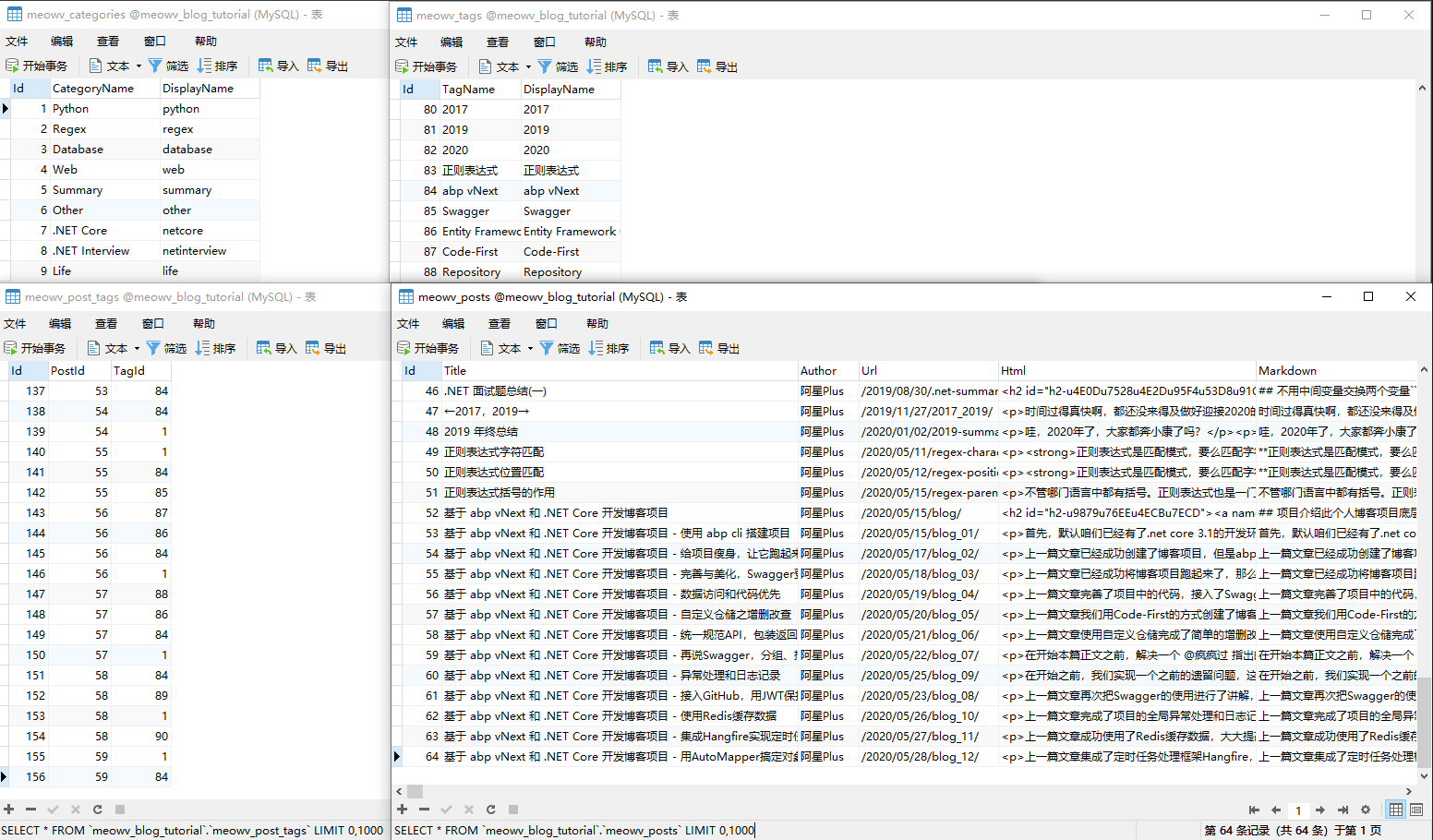
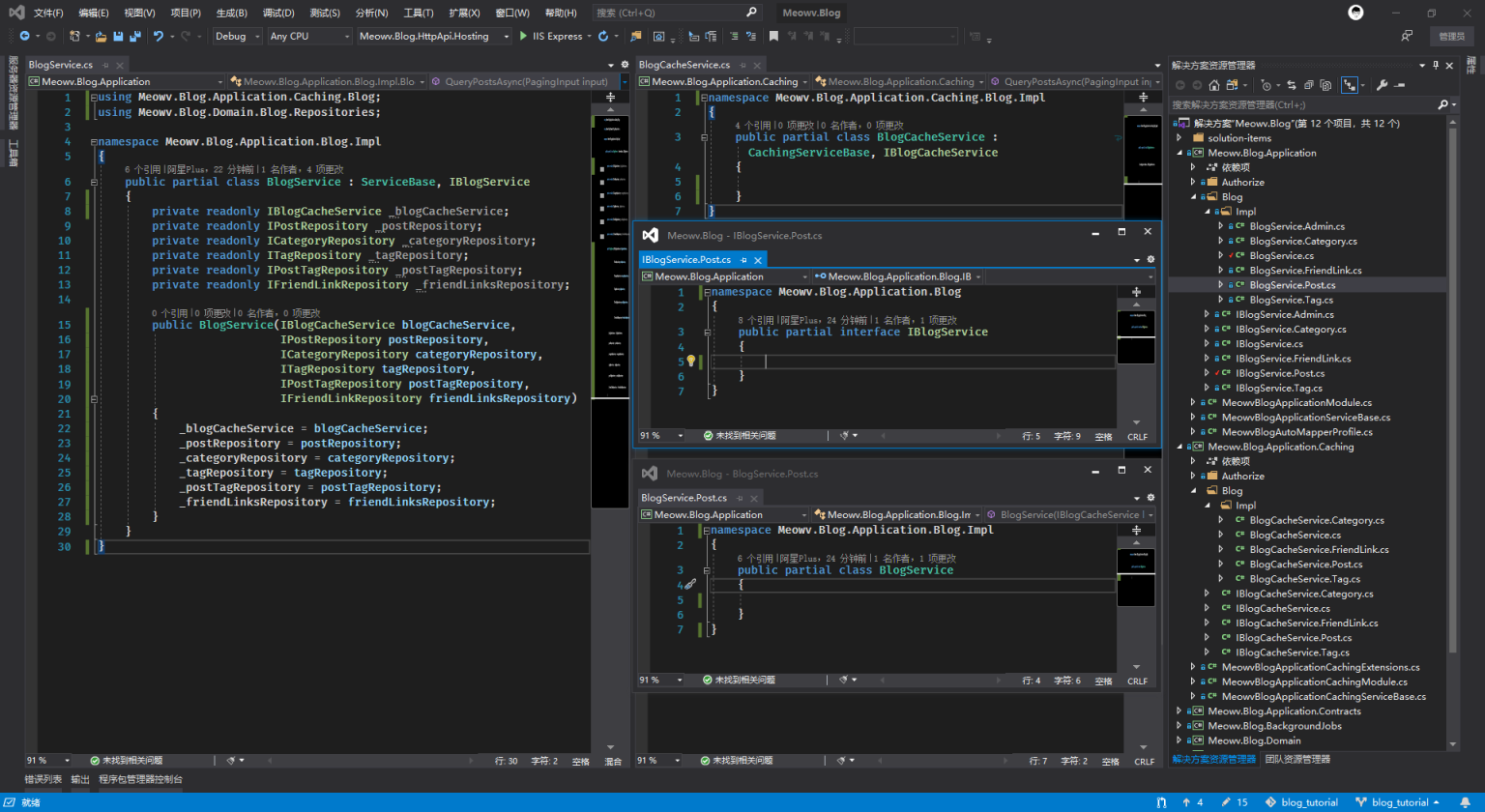
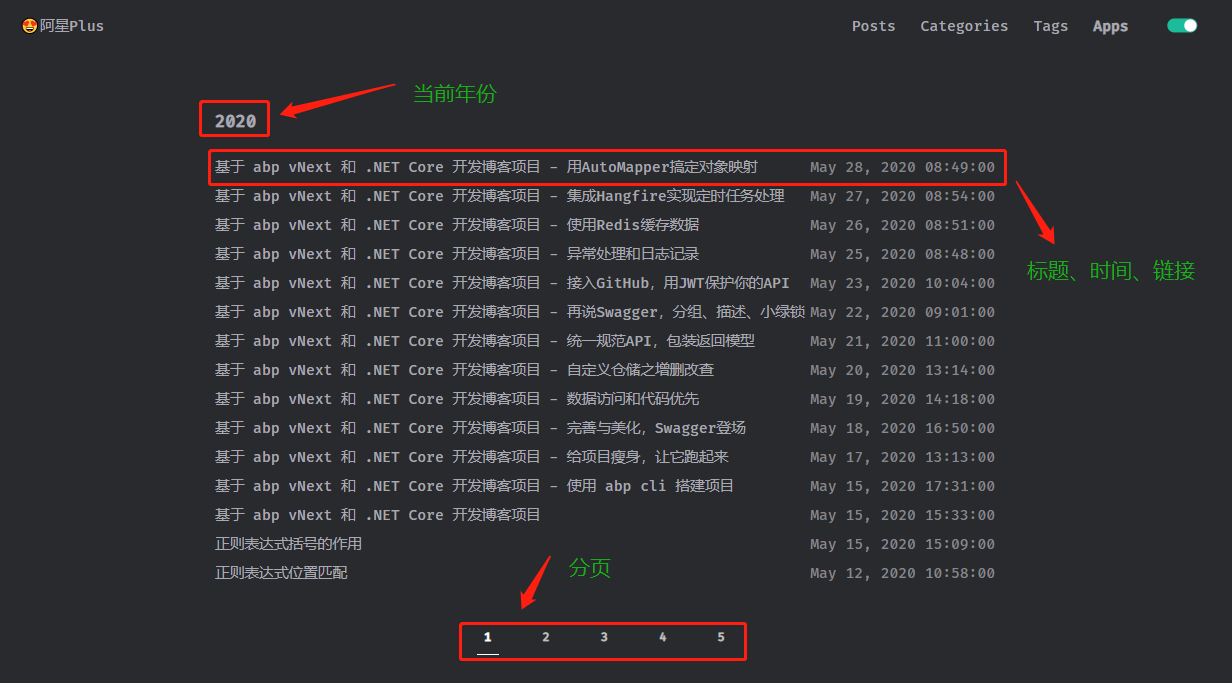
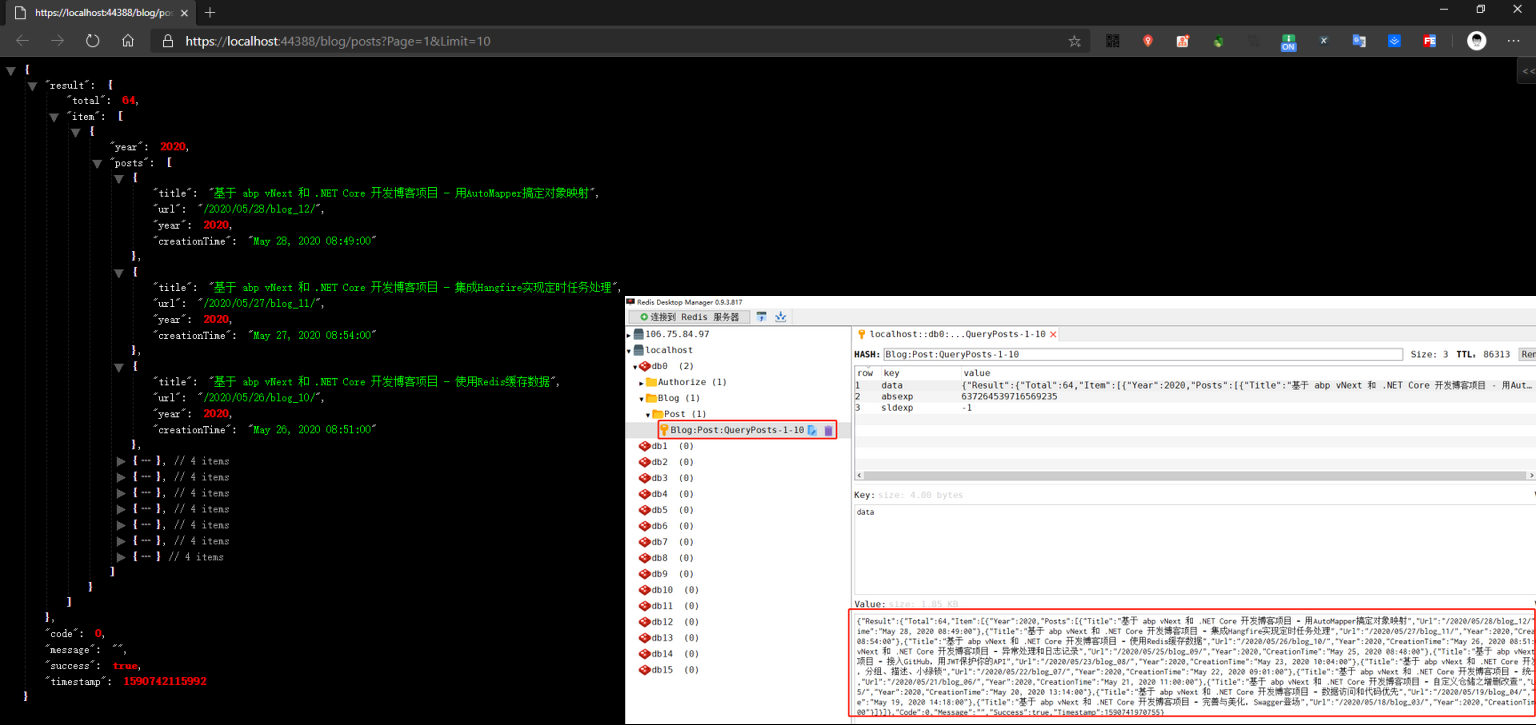
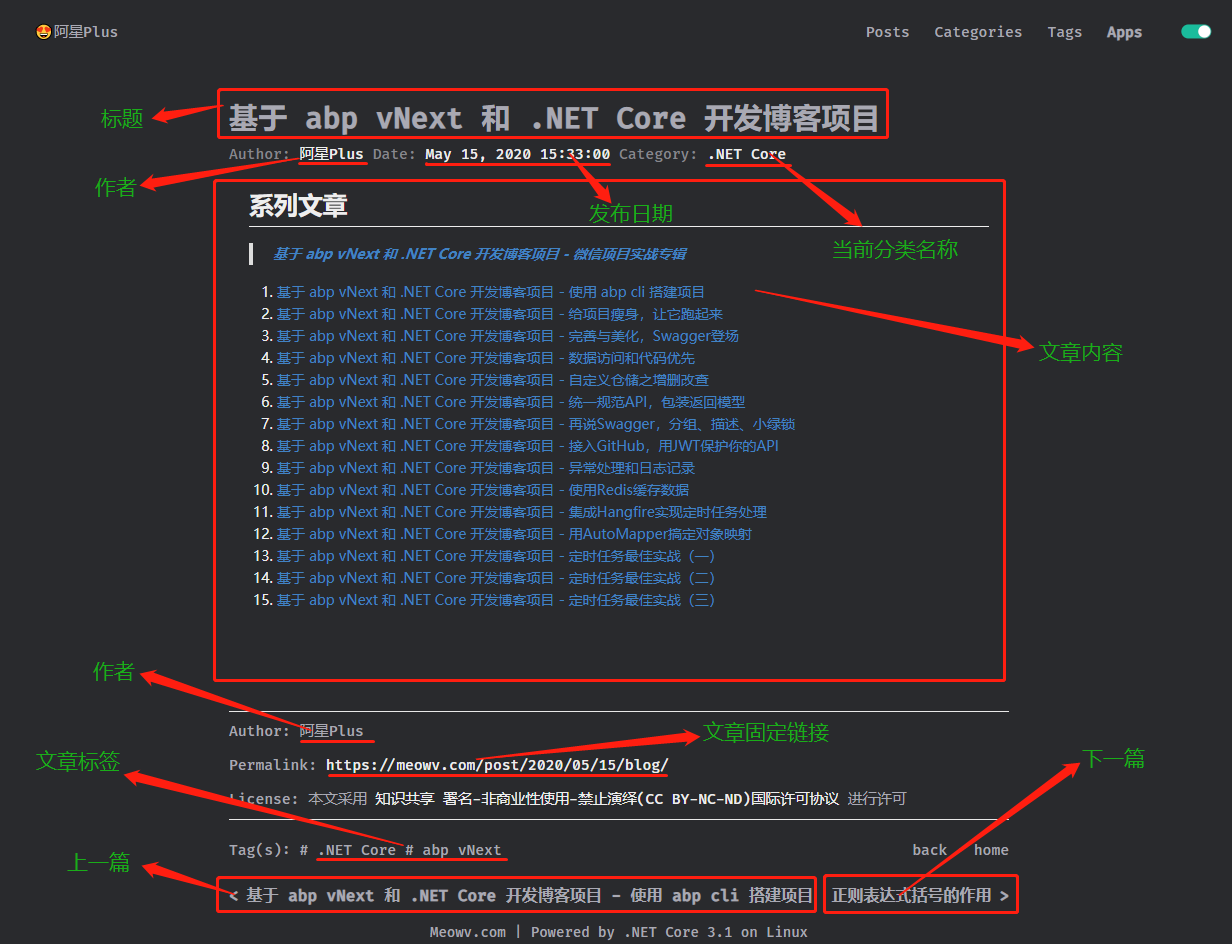
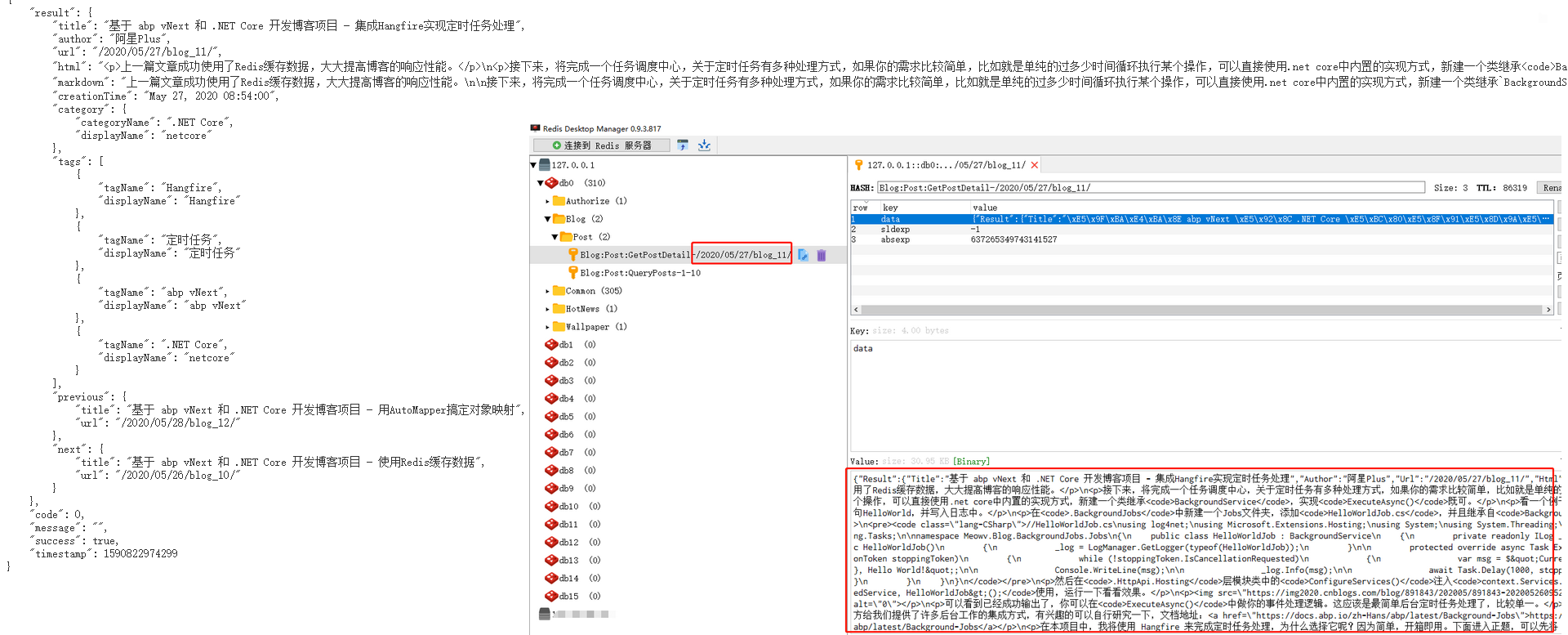
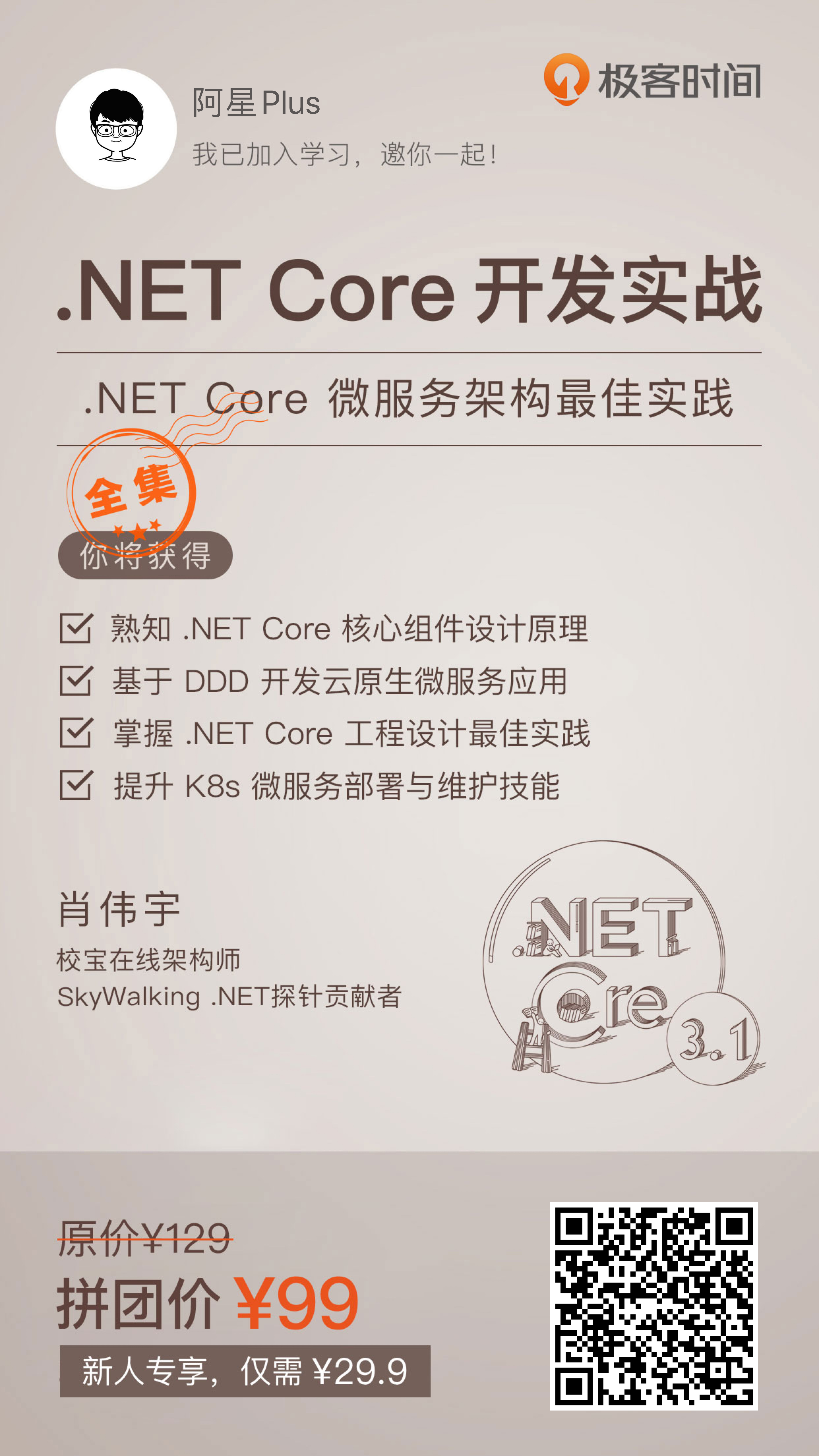


【推荐】国内首个AI IDE,深度理解中文开发场景,立即下载体验Trae
【推荐】编程新体验,更懂你的AI,立即体验豆包MarsCode编程助手
【推荐】抖音旗下AI助手豆包,你的智能百科全书,全免费不限次数
【推荐】轻量又高性能的 SSH 工具 IShell:AI 加持,快人一步
· 10年+ .NET Coder 心语,封装的思维:从隐藏、稳定开始理解其本质意义
· .NET Core 中如何实现缓存的预热?
· 从 HTTP 原因短语缺失研究 HTTP/2 和 HTTP/3 的设计差异
· AI与.NET技术实操系列:向量存储与相似性搜索在 .NET 中的实现
· 基于Microsoft.Extensions.AI核心库实现RAG应用
· TypeScript + Deepseek 打造卜卦网站:技术与玄学的结合
· 阿里巴巴 QwQ-32B真的超越了 DeepSeek R-1吗?
· 【译】Visual Studio 中新的强大生产力特性
· 10年+ .NET Coder 心语 ── 封装的思维:从隐藏、稳定开始理解其本质意义
· 【设计模式】告别冗长if-else语句:使用策略模式优化代码结构